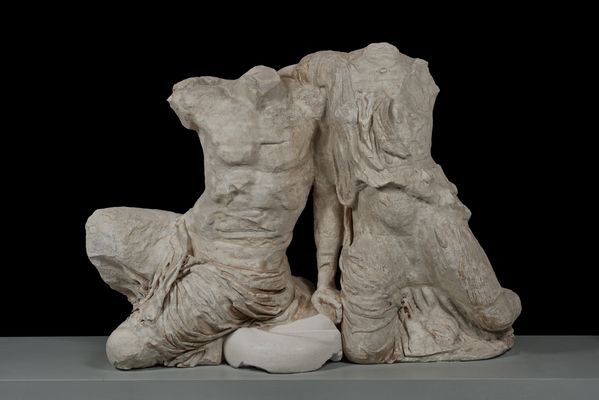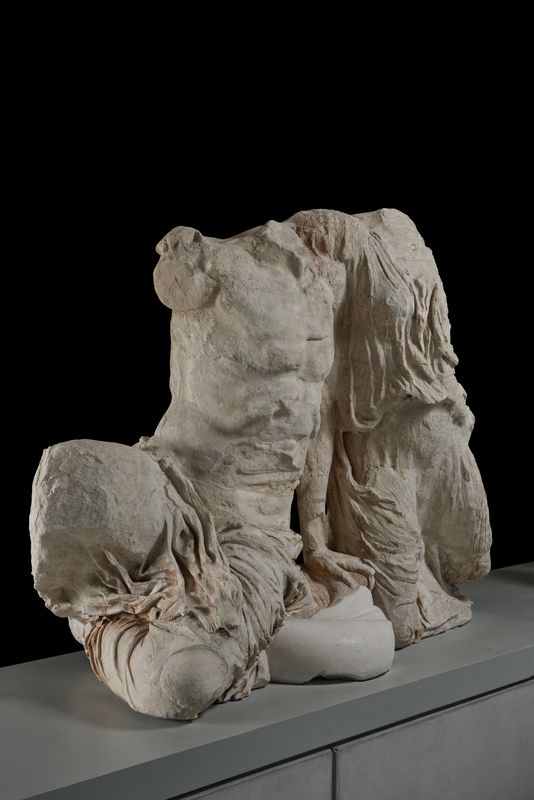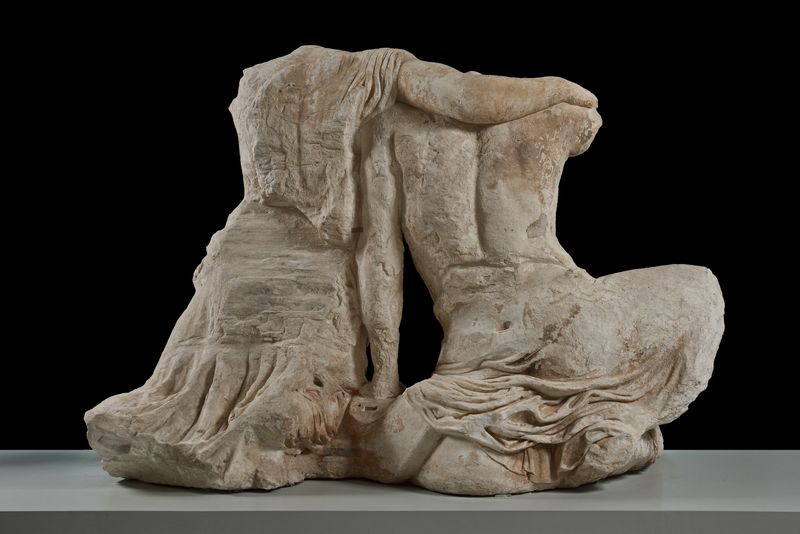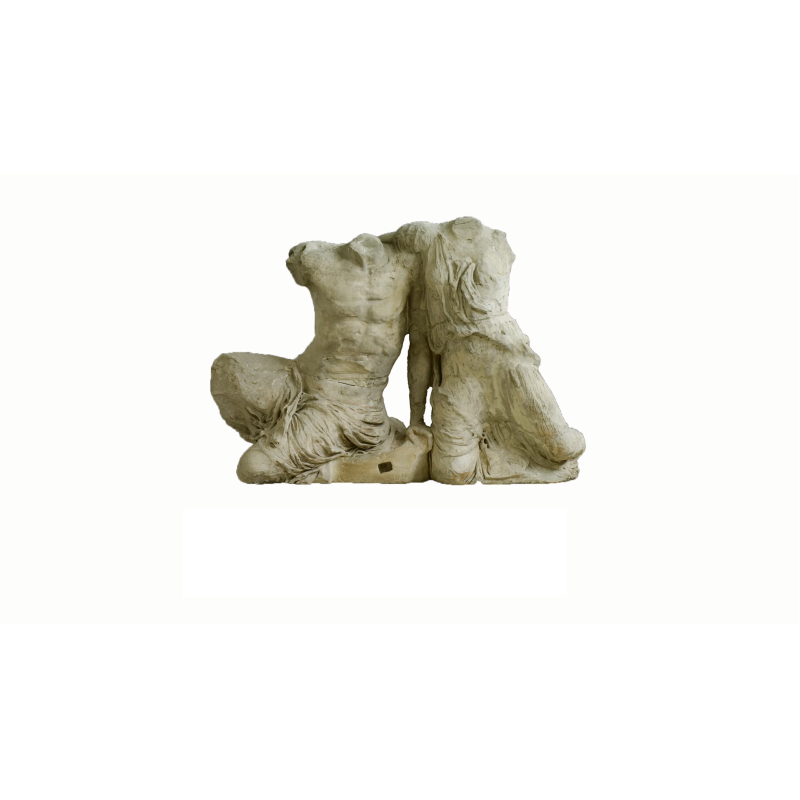Parthenon. West pediment. Kekrops and Pandrosos
Inventory number
Ακρ. 14935
Artist
Pheidias' workshop
Category
Architectural sculpture
Period
Classical Period
Date
437-432 BC
Dimensions
Height: Kekrops 1.27 m
Height: Pandrosos 1.37 m
Length: group 1.84 m
Width: group 0.6 m
Material
Marble from Penteli
Location
Parthenon Gallery
Two statues made from the same piece of marble that are interpreted as Kekrops and his daughter Pandrosos.
The figures kneel on the ground while they are turned towards the scene of the dispute between Athena and Poseidon, which was placed in the centre of the pediment. The man with his himation around his waist rests on his left arm and raises his right hand in which perhaps he held some sort of sceptre. The young woman depicted in a smaller scale embraces with her right arm her father's shoulders. She is dressed in a belted chiton that leaves her left breast uncovered. Her himation falls over the chiton and is wrapped around her right thigh. A snake sculpted in a separate piece of marble coils between the two figures indicating the king's Kekrops native origin.
The statues were in their original place on the temple's pediment until 1977 when they were removed for their protection from air pollution and bad weather conditions. Their heads, parts of their arms, as well as the snake, were broken off beforehand and lost. Only a part of the snake, currently in the British Museum in London, has been preserved after it was forcefully detached by Thomas Bruce, lord of Elgin, who removed most of the sculptures that he found on the pediments between 1801 and 1804 when Greece was still under Ottoman occupation. In the Acropolis Museum a plaster copy of the snake is exhibited.
The west pediment of the Parthenon portrays the dispute between Athena and Poseidon regarding who would become the divine protector of Athens. The contest was held on the Acropolis in the presence of the city mythical kings Kekrops and Erechtheus and other local heroes, who as judges decided the outcome in favour of Athena, preferring her gift, the olive tree, to the salty water offered by Poseidon. The centre of the scene is occupied by the two protagonists and their chariots whereas the pediments' corners contain the personifications of two rivers that flowed in ancient Athens, Ilissos and Kephissos. Due to the misadventures suffered by the monument over the following centuries many sculptures have been lost, some survive in mutilated form whereas others are represented only in small fragments.
The two Parthenon pediments are adorned with about fifty oversized statues. The sculptures, perfectly worked even on their unseen, rear sides, present scenes from the myths of the goddess Athena.
Report from the Select Committee of the House of Commons on the Earl of Elgin's collection of sculptured marbles, London, 1816, σελ. 29, 117-118
Visconti, E.Q., A Letter from the Chevalier Antonio Canova and two memoirs read to the Royal Institute of France on the sculptures in the collection of the Earl of Elgin, London, 1816, σελ. 30-32
Stuart, J., Revett, N., The Antiquities of Athens measured and delineated, τόμος IV, 1816, σελ. VI, 20-21
Dodwell, E., Classical and Topographical Tour through Greece during the years 1801, 1805 and 1806, vol. 1, London, 1819, σελ. 325, 328-329
Michaelis, Α., Der Parthenon, Leipzig, 1870-1871, σελ. 193-194, πίν. 7-8, αρ.κατ. 2 (BC)
Collignon, M., Phidias, Paris, 1886, σελ. 57
Sauer, B., «Standplatten der Giebelgruppen», Antike Denkmäler I, 5, 1890, σελ. 49, πίν. 58A
Furtwängler, A., Masterpieces of Greek Sculpture, London, 1895, σελ. 451-463, εικ. 183
Smith, A.H., A Catalogue of the Sculptures of the Parthenon in the British Museum, London, 1906, σελ. 42-44, αρ.κατ. 304BC
Smith, A.H., British Museum. The Sculptures of the Parthenon, London, 1910, σελ. 16-17, εικ. 29, πίν. 8
Lethaby, W.R., «The West Pediment of the Parthenon», Journal of Hellenic Studies 50, 1930, σελ. 6-7, 14, εικ. 2-3
Picard, C., La Sculpture II. Période Classique - Ve siècle, Manuel d'Archéologie Grecque II. 2, Paris, 1939, σελ. 499-501, εικ. 206-207
Becatti, G., Problemi fidiaci, Milano/Firenze, 1951, πίν. 15.40-41
Fehl, P., «The Rocks on the Parthenon Frieze», Journal of the Warburg and Courtauld Institutes 24, No. 1/2 (Jan. - Jun), 1961, σελ. 23-24, πίν. 5a
Brommer, F., Die Skulpturen der Parthenon-Giebel, Mainz, 1963, σελ. 32-33, 166-167, εικ. 85-89
Becatti, G., «Postille partenonice: i frontoni», Archeologia Classica 17, 1965, σελ. 76-78, πίν. XXII
Harrison, E.B., «U and her Neighbors in the West Pediment of the Parthenon», στο F. Douglas, H. Hibbard, M.J. Lewine (επιμ.), Essays in the History of Art Presented to Rudolf Wittkower, London, 1967, σελ. 9 υποσημ. 55
Brommer, F., «Studien zu den Parthenongiebeln V», Mitteilungen des Deutschen Archäologischen Instituts. Athenische Abteilung 84, 1969, σελ. 114
Kron, U., Die zehn attischen Phylenheroen: Geschichte, Mythos, Kult und Darstellungen, Mitteilungen des Deutschen Archäologischen Instituts, Athenische Abteilung: Beiheft 5, Berlin, 1976, σελ. 84-103, 261, αρ.κατ. Κ25
Berger, E., «Parthenon-Studien: Zweiter Zwischenbericht», Antike Kunst 20, 1977, σελ. 138 υποσημ. 56
Lindner, R., «Die Giebelgruppe von Eleusis mit Raub der Persephone», Jahrbuch des Deutschen Archäologischen Instituts 97, 1982, σελ. 318-330, εικ. 12-17
Casanaki, M., The Acropolis at Athens, Conservation, Restoration and Research, 1975-1983, Athens, 1983, σελ. 68
Beschi, L., «L. S. Fauvel e il Partenone», στο E. Berger (επιμ.), Parthenon-Kongress Basel: Referate und Berichte, 4. bis 8. April 1982, Mainz, 1984, σελ. 322-323, εικ. 60.3
Weidauer, L., «Eumolpos und Athen. Eine ikonographische Studie», Archäologischer Anzeiger 1985, σελ. 204-207
Cook, B.F., «Parthenon West Pediment B/C: the Serpent Fragment», Kanon Festschrift E. Berger, AntK-BH 15, 1988, σελ. 4-8, εικ. 1-3
Kearns, E., «The Heroes of Attica», Bulletin of the Institute of Classical Studies Suppl. 57, 1989, σελ. 110-113, 139-140, 161-162, 175-176, 192-193
Palagia, O., The Pediments of the Parthenon, Boston, 1993, σελ. 41-43, εικ. 3, 5, 7a, 78-79
Δεληβορριάς, Α., «Ο γλυπτικός διάκοσμος του Παρθενώνα», στο Π. Τουρνικιώτης (επιμ.), Ο Παρθενώνας και η Ακτινοβολία του στα Νεώτερα Χρόνια, Αθήνα, 1994, σελ. 111, εικ. 25
Τριάντη, Ι., Το Μουσείο Ακροπόλεως, Ο Κύκλος των Μουσείων, Αθήνα, 1998, σελ. 254, 264-265, εικ. 265-266
Rolley, Cl., La Sculpture Grecque. La periode classique, 2, Paris, 1999, σελ. 77, εικ. 88
Μαλλούχου-Tufano, Φ., «1975-1999 Μελέτες, έρευνες, έργα στην Ακρόπολη: Χρονολόγιο», Ενημερωτικές ειδήσεις από την αναστήλωση των μνημείων της Ακρόπολης τεύχος 1, 2001, σελ. 4
Holtzmann, B., L’ Acropole d’Athènes. Monuments, cultes et histoire du sanctuaire d’Athèna Polias, Paris, 2003, σελ. 140-141, εικ. 131
Choremi-Spetsieri, A., Τhe Sculptures of the Parthenon. Acropolis-British Museum-Louvre, Athens, 2004, σελ. 139-142, εικ. 99
Zambon, A., «Louis-François-Sébastien Fauvel et la constitution de la collection Choiseul-Gouffier», στο O. Cavalier (επιμ.), Le voyage en Grèce du comte de Choiseul-Gouffier, Avignon, 2007, σελ. 73
Vlassopoulou, Chr., «New Investigations into the Polychromy of the Parthenon», στο V. Brinkmann, O. Primavesi, M. Hollein (επιμ.), Circumlitio. The Polychromy of Antique and Mediaeval Sculpture. Proceedings of the Johann David Passavant Colloquium, 10-12 December, München, 2010, σελ. 218-223, εικ. 166-167
Manidaki, V., «The replacement of sculptured architectural members on the monuments of the Acropolis. Casts, copies and authentic members», The Acropolis Restoration News 11, July, 2011, σελ. 23, 25
Strocka, V.M., «Hadrian und Kekrops», Mitteilungen des Deutschen Archäologischen Instituts. Athenische Abteilung 127/128, 2012/2013, σελ. 289-305
Di Cesare, R., «L'Acropoli e i re di Atene», στο F. Longo, R.Di Cesare, S. Privitera (επιμ.), ΔΡΟΜΟΙ. Studi sul mondo antico offerti a Emanuele Emanuele Greco dagli allievi della Scuola Archeologica Italiana di Atene II, Paestum, 2016, σελ. 721-723, εικ. 8
Παντερμαλής, Δ., Ελευθεράτου, Σ., Βλασσοπούλου, Χ., Μουσείο Ακρόπολης. Οδηγός, Αθήνα, 2016, σελ. 214-215, εικ. 259
Katsaros, Th., Vasiliadis, C., «Polychromy in Greek Sculpture», στο O. Palagia (επιμ.), Handbook of Greek Sculpture, Ancient Greek and Roman Art and Architecture, Berlin/Boston, 2019, σελ. 715-716, εικ. 22.19


